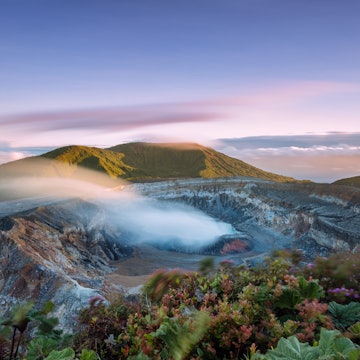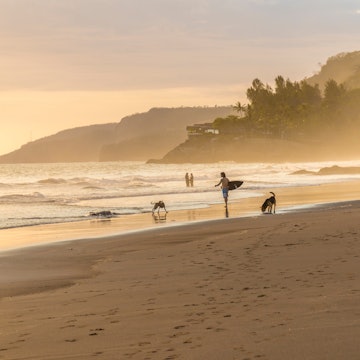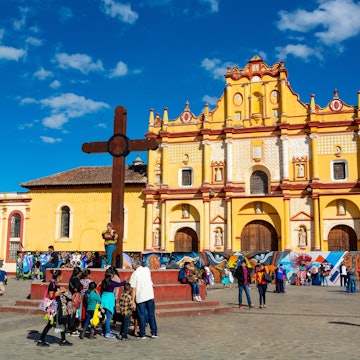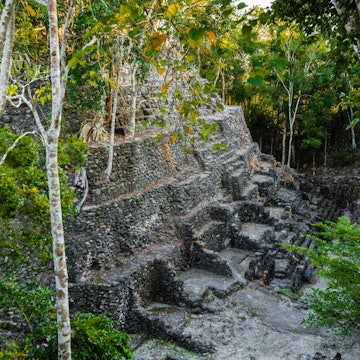

Snorkeling along the Mesoamerican Barrier Reef, Roatán, Honduras. Solarisys/Shutterstock
Some 40 miles (65km) off the northern coast of Honduras, Roatán is a dream for diving enthusiasts.
The largest of the Bay Islands, Roatán is fringed by the Mesoamerican Barrier Reef (the second-largest in the world) – and beckons to scuba divers, snorkelers and others who want to spend their days in or on the sea. Since the perennially warm water has mild currents year-round, marine life is abundant and the reef is largely healthy, Roatán’s affordability and accessibility are delightful surprises.
But there’s far more to Roatán than diving. Even in its most developed areas, the island exudes a funky, laid-back charm that’s increasingly rare to find in the age of mass tourism. In the span of a few days, you can sip tropical cocktails on a lively rooftop bar, zip-line across the jungle, eat freshly caught fish from a beach shack, learn to kitesurf, lie out on a deserted beach and snorkel from shore.
Here’s everything you need to know before your first visit. One key tip from the get-go: Roatán’s mix of adventure and relaxation may have you planning your return trip before you even head home.

When should I go to Roatán?
In general, the best times to visit Roatán are April, May (being careful to avoid Semana Santa, leading up to Easter) and September. Spring brings dry, sunny days, calm seas, and breezy, easterly trade winds that keep things comfortable. The dry and hot conditions of September are optimal for diving, with summer crowds having thinned out and biting insects (mostly) in retreat.
Yet other times of the year also appeal. June and July are ideal for diving, with fierce winds rare and only brief rain showers. During the Thanksgiving-to-Easter high season, the island’s warm water and reef-lined shores draw visitors escaping colder climates. Partially overlapping with hurricane season, October through December are typically rainy, with November historically the wettest month.
About that hurricane season (officially June through November): south of the main hurricane belt, Roatán generally avoids direct hits. Its barrier reef also acts as a natural shield, so while you may encounter passing storms, strong winds or tumultuous waves, especially in autumn and on the island’s north and west sides, they’re typically brief.
Another seasonal consideration is the widespread agricultural burning that takes place across Roatán in May. Aside from reduced visibility, heavy smoke may cause watery eyes, a sore throat or even respiratory problems, and might temporarily suspend airport operations. The air typically clears up by late afternoon most days, but you may want to pack a face mask if you’re visiting in May.

How much time should I spend in Roatán?
One week in Roatán provides a sufficient introduction: you can dive a few sites, lounge on West Bay Beach for a day or two, and get a taste of the island’s laid-back rhythm. But you’ll likely find yourself wanting more time here – particularly since you’ll have to choose to stay either in lively, sun-drenched West End or the quieter, more secluded East End.
If possible, give yourself 10 to 14 days. That timeframe lets you explore both vastly different ends of the island, dive a much wider range of sites, paddle through mangroves or fly over the treetops on a zip-line – with time to spare to laze in a hammock or linger over a dinner of freshly caught seafood. The extended timeframe also provides a buffer in case unfavorable weather disrupts any of your plans.

Is it easy to get to and around Roatán?
Roatán’s entry requirements are refreshingly simple. Travelers from the US, Canada, most European nations and several other countries don’t need a visa for visits to Honduras under 90 days. Note that under Honduran law, all children under 21 traveling alone or with only one parent must carry notarized permission from the non-traveling parent(s) to enter or exit the country.
You can reach Roatán’s international airport on direct flights from several US hubs, as well as shorter flights from elsewhere in Honduras and Central America. For a potentially cheaper option, consider booking a flight to San Pedro Sula on the mainland, and hop a domestic CM or Sosa Airlines flight.
The Galaxy Wave ferry from La Ceiba takes about 90 minutes and runs twice daily, offering an affordable and often more reliable – because less weather-dependent – alternative. Roatán’s two cruise ports, Mahogany Bay and Port of Roatán, welcome ships year-round.
Once you arrive, getting around Roatán is relatively straightforward – as long as you don’t rely on public transportation, since buses don’t follow a regular schedule or even have official stops. Opt for taxis instead, which are widely available across the island. Roatán has two types: private taxis, and inexpensive colectivos that you’ll share with others. Whichever you take, be sure to get into only licensed taxis (white, with license numbers on the sides) and agree on the fare up front. Taxis from the airport have set rates; elsewhere, a good rule of thumb for other fares is to counter the driver’s offer with 20% less. Ask around at your hotel, as most know one or two trusted local taxi drivers.
If you plan to explore both ends of Roatán, renting a car offers more flexibility – just be prepared for rough, pothole-riddled roads and a disarming lack of signs. West Bay and West End are both walkable, with water taxis the best way to travel between the two. These zip back and forth daily from 7am to 6pm and cost from $4 to $6 per person.
Top things to do in Roatán
Roatán offers epic adventures both underwater and above ground, from zip-lining and golf to sailing, kitesurfing and sport fishing.

Experience firsthand why scuba diving Roatán lives up to the hype
The Mesoamerican Barrier Reef essentially surrounds Roatán, providing walls, drift dives, swim-throughs and wrecks just minutes from shore. This means you could dive every day for a week and never repeat the same experience. (Every night, too: many dive shops offer shark dives and night dives, the best time to see octopus and squid.) Since most operators consistently earn five-star ratings, you can all but pick one at random and have an incredible time. I did just that with Sun Divers and Roatán Divers, and highly recommend both.
Consider buying a multi-dive package from one shop to save. And if night diving appeals to you, plan your trip for a new moon. The rare bioluminescent phenomenon known as the “string of pearls” happens shortly after sunset during a new moon cycle.
Go snorkeling
Not a diver? You’ll still find plenty to love here beneath the surface – and just offshore, meaning you can wade in from the beach. For a fuller experience, book a spot on a boat tour to reach wrecks, caves and secluded channels. Most tours include multiple stops and depart from West End, with crews choosing locations based on daily conditions. If you know anyone at local dive shops, ask if they’ll take you out to snorkel while others dive.
If you go the DIY route, be extremely mindful of boat traffic and stick to designated entry points for snorkelers. Top spots include the rocky wall near the Kimpton Grand Roatán Resort; in front of Infinity Bay; and Half Moon Bay, especially its left side as you face the water, where coral reefs lie just beyond a stretch of seagrass. You can rent snorkeling gear from shops throughout West Bay and West End.

Soak up the sun on west coast beaches
You’ll find some of the most stunning beaches in Central America on Roatán’s west coast. West Bay Beach is the showstopper, with white sand and clear, bright blue water – but it draws big crowds, especially when cruise ships are in port. (In general, we recommend planning your beach days around the cruise ship schedule. Hit the sand before 9am or after 3pm, and wander past the resorts to find quieter stretches.)
For a more laid-back vibe, smaller Half Moon Bay has the same stunning scenery but fewer crowds and vendors. Tiny Playa West End is always deserted despite being near the center of town, making it ideal for swimming.
Contribute to conservation efforts by spear-hunting lionfish
Get way off the tourist path and protect Roatán’s pristine reefs by hunting invasive lionfish in Roatán Marine Park. The spiny, eye-catching fish reproduce rapidly (every few days, year-round, for their entire lives!) and prey on native species, ultimately damaging delicate coral reefs. The marine park hosts licensing workshops twice a week in Half Moon Bay, during which you can learn how to safely and effectively spear lionfish while snorkeling or diving. Once certified, you’ll get a permit – and your own spear.

My favorite thing to do in Roatán
My number-one recommendation in Roatán? Rent a vehicle for at least a day and make the 60- to 90-minute drive to the East End. Rustic, ruggedly beautiful and remote, this side of the island provides a total contrast to the west side’s bustling resort scene.
Camp Bay Beach is by far Roatán’s most secluded stretch of sand. Overwater-bungalow restaurant La Sirena de Camp Bay is the dreamiest lunch spot I’ve ever been to, with hummingbirds fluttering around you as a local band plays live music. Swing by Roatán Island Brewing Co. for a beer in the middle of the jungle – or enjoy steak, lobster and a free hand-rolled cigar at the aptly named Hole in the Wall. (It’s accessible only by boat: go to the convenience store in Jonesville – there’s only one – and ask the clerk to call the bar. They’ll send their boat over to pick you up within minutes.) Finally, on Sundays, don’t miss welcoming drum circles, dancing and delicious home-cooked food in the Garifuna village of Punta Gorda, the island’s oldest community.
How much money do I need for Roatán?
Roatán offers travelers a solid value. If it’s not quite as wallet-friendly as Guatemala or Nicaragua, it’s substantially more affordable than Belize, Costa Rica and many other Caribbean islands, and you’ll find notably reasonable prices on food, hotels, tours and diving. Not including dives or accommodation, budgeting US$100 per day, per person, is a safe bet.
US dollars are widely accepted – just be sure to bring crisp, clean bills in small denominations ($20 or less; ones and fives for tipping), as many businesses do not accept torn or marked bills. Stick to ATMs inside the airport or at Petrosun gas stations; elsewhere, the machines are frequently compromised.
Upscale sit-down dinner: $18–25 per person
Street-food meal: $6–10
Baleada, essentially the Honduran version of a taco: $1–2
Local beer at a restaurant: $2–5
Cocktail at a beach bar: $6–8
Cup of coffee at a cafe: $2–5
Water-taxi ride: $4–6
Taxi from the airport to West End: $20–25
Hostel/dorm room: $30–40 per night
Mid-level hotel room in West Bay: $130–250 per night
Mid-level hotel room in West End: $40–85 per night
Luxury hotel room: $270–400 per night
Vacation rental: $120–300 on the west coast; $60–120 in the East End
Snorkeling tour: $80–130, depending on number of stops
Dive trip: $40–45 per tank

Ethical tourism in Roatán
Sadly, Roatán is home to a number of tourist traps that use “greenwashing” to market themselves as eco-friendly animal sanctuaries. Holding sloths or swimming with captive dolphins may not seem too disruptive, but such activities cause real harm to these wild animals, who are forced to interact with hundreds of humans every week. If you want to see animals in their natural habitat, stick to snorkeling or diving.
Tipping in Roatán
Much as in the US, tipping service workers is customary in Roatán – and here, that even includes grocery baggers. Some restaurants, particularly in West Bay, include a tip on the bill (often called a “service charge”), so double check before settling up.
Only drink bottled water in Roatán
Tap water in Honduras isn’t safe to drink, even in major cities and at upscale resorts. To avoid getting sick, stick to sealed bottled water. Most hotels and vacation rentals have water-filtration systems for brushing your teeth – but ask first, and have some extra bottles on hand just in case.
Choose your souvenirs carefully in Roatán
Skip souvenirs made from coral, conch shells, seahorses, starfish and any other marine life. Not only are these items almost always made from unethically sourced material, but they’re also likely to be confiscated at customs.













